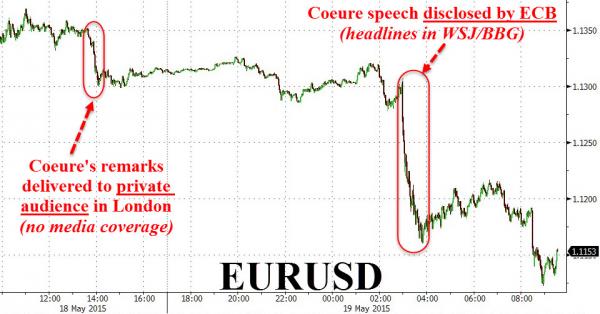Until May, as part of its Public Sector Purchase Programme (aka QE), the ECB bought just over €47 billion in Eurozone (excluding Greece of course) government bonds. Then, after Gross said, and Gundlach chimed in, that the German Bund is “the short of a lifetime” the Bund cratered in one of the most sharp and dramatic moves seen in recent years, plunging from under 0.1% to nearly 0.8%, before finally stabilizing around 0.5% in recent days.
All of this took place as the ECB’s Benoit Couere leaked, with a 10 hour head start, ECB strategy to a select group of hedge funds, when in a speech on May 18, he said that “the ECB is aware of seasonal patterns in the bond market and that there is generally less liquidity on the market from mid-July to August. “The Eurosystem is taking this into account in the implementation of its expanded asset purchase program by moderately front loading its purchase activity in May and June,” he said. The leak has since been blamed on an “internal procedural error” and has even gotten the European Ombudsman involved in this latest gross leak by the ECB, one which moved the EURUSD substantially.
Â

Â
In any event, the ECB did just as leaked in advance.
Moments ago the ECB released its latest QE purchase data in which we find that total bond purchases jumped by over 8% in the month of May, to over €51 billion, from the previous average over just around €47 billion. This was driven by a jump in German (+8.9%), French (+10%), Italian (+7.4%) and Spanish (+8%) purchases.

Â
Not surprisingly, this jump in purchases above the trendline meant the ECB had to buy ever more shorter maturity securities, and the average weighted maturity of purchases across the Eurozone (excluding Greece) dropped once more, this time to 8.07 years, from 8.25 years the month before and 8.56 in March.

Â
Why did the ECB do this? Simple – as we explained in “ECB’s Bizarro QE Taper May Add To Summer Bond Market Volatility, Citi Says”, the month of May is when net European issuance had the biggest buffer. In fact, May was the highest net issuance months left in 2015. It is all downhill from here, and after a mixed June in which net issuance will be negative comes July, which will be an absolutely horrible month for Bund shorts, in which net issuance may be the most negative in recent (and upcoming) European history.

